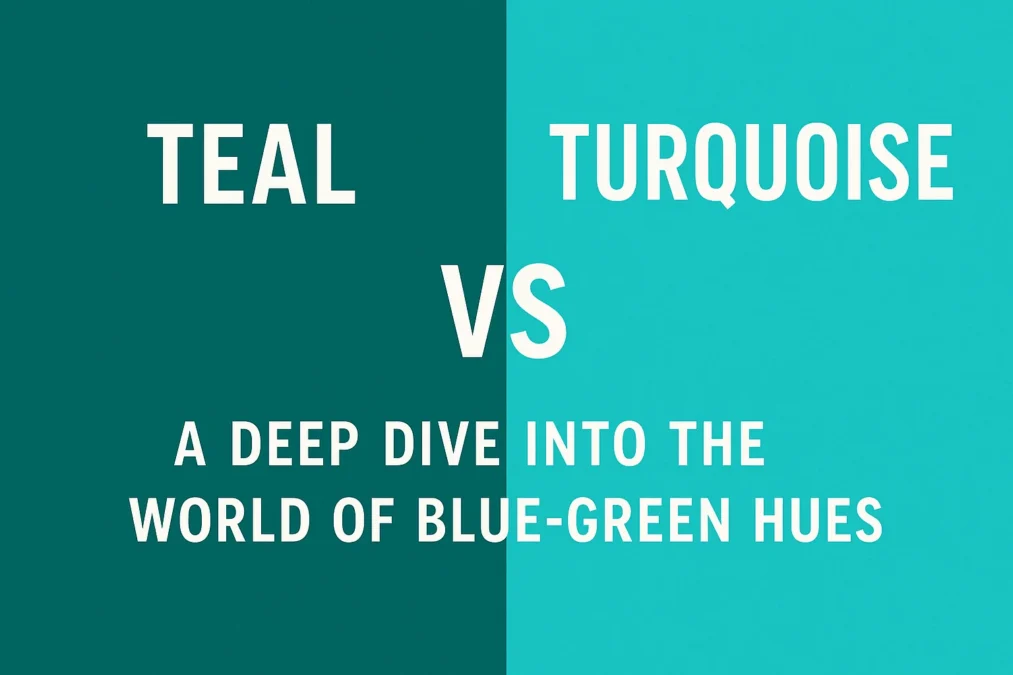Have you ever found yourself staring at a stunning piece of artwork, a gorgeous website design, or a beautiful item of clothing, utterly captivated by a specific color, but completely unable to decide if it’s teal or turquoise? You are not alone. This is one of the most common color confusion scenarios in the creative and design world. Both teal and turquoise belong to the enchanting blue-green color spectrum, a family of shades that evoke feelings of the ocean, tropical lagoons, and precious gemstones. Their similarities are undeniable, which is precisely why the distinction can feel so elusive.
But fear not, for the differences, while sometimes subtle, are absolutely distinct and deeply fascinating. Understanding the nuances between teal and turquoise is more than just a pedantic exercise for artists; it’s a key tool for anyone interested in interior design, fashion, branding, and even psychology. The choice between these two colors can dramatically alter the mood, tone, and impact of a project. This comprehensive guide will serve as your ultimate resource, breaking down everything from their technical definitions and historical origins to their modern applications and psychological effects. We will settle the great teal vs turquoise debate once and for all, and along the way, we’ll also clarify where aqua and cyan fit into this vibrant puzzle.
Understanding the Color Spectrum: Where Blue Meets Green
Before we can isolate teal and turquoise, we need to understand the playground they exist in. The color wheel is a beautiful and logical system, but the space between primary blue and primary green is not a simple line; it’s a vast and varied territory. Imagine a gradient that slowly transitions from the deepest navy blue, through shades like cyan and azure, then into a perfect balanced blue-green, onward to shades that lean more heavily into green, and finally arriving at a pure emerald. This journey is where our two main characters reside.
The creation of these in-between shades, known as tertiary colors, happens when you mix a primary color with a secondary color. In this case, blue (primary) is mixed with green (secondary, which itself is made from blue and yellow) to create the blue-green spectrum. The specific ratio of blue to green is the primary dictator of where a color falls on this spectrum. A mix with more blue will feel cooler, calmer, and more oceanic, while a mix with more green will feel more vibrant, energetic, and earthy. This fundamental principle of ratio is the first key to unlocking the teal vs turquoise color mystery. It’s not about magic; it’s about mathematics and pigment.
Furthermore, saturation and value play enormous roles in how we perceive these colors. Saturation refers to the intensity or purity of the color. A highly saturated blue-green is vivid and bold, while a desaturated one appears more muted, grayish, or dusty. Value refers to the lightness or darkness of the color. Adding black creates a shade (darker), adding white creates a tint (lighter). Teal and turquoise each have their own typical ranges within these parameters, which helps us identify them even when the blue-green balance is very close.
What is Teal? The Depth of the Wilderness
Let’s start by diving into the deeper, more mysterious end of the pool: teal. The very name offers a clue to its origin. Teal is named after the common teal bird, a species of freshwater duck that boasts a strikingly dark bluish-green stripe around its eyes. This connection to nature grounds the color in a sense of organic sophistication. It’s not the flashy color of a tropical tourist destination; it’s the color of a serene, shaded pond deep within a forest.
From a technical standpoint, teal is defined as a dark blue-green. It is a low- to medium-value color, meaning it is inherently quite dark. It is created by combining blue and green pigments, but with a significant addition of black (or by using a very deep blue as a base) to deepen and gray the tone slightly. This addition is crucial. It desaturates the color, giving teal its characteristic muted, sophisticated, and slightly somber quality. In many digital color models, teal is often represented as a hex code around #008080, a code that signifies a balanced but dark blend of green and blue.
The personality of teal is complex. It carries the calming, stable reliability of blue but is infused with the renewal and growth associated with green. However, because it is darkened, it expresses these traits in a more subdued, mature, and introspective way. Teal feels grounded, elegant, and wise. It’s not a color that shouts for attention; rather, it commands respect through its quiet depth. It evokes images of deep pine forests surrounding a dark lake, the dense plumage of the bird it’s named after, and the intricate patterns of malachite or dark jade.
What is Turquoise? The Jewel of the Sea
If teal is the depth of the forest, turquoise is the light of the tropics. The name turquoise comes from the French word “pierre turquoise,” meaning “Turkish stone,” as the gemstone was first brought to Europe from Turkey. This origin story immediately sets a different tone—one of trade, luxury, and exotic beauty. The turquoise gemstone has been prized for millennia by ancient cultures from Egypt to Persia to the Native Americans of the Southwest, often revered for its protective and healing properties.
Technically, turquoise is a brighter, more vibrant blue-green that leans more distinctly towards blue than green, but retains a very visible green presence. It is a medium-value color, meaning it is not particularly dark or light in its pure form, though it can be found in many tints. Crucially, turquoise is characterized by its high saturation. It is a vivid, intense color, often feeling luminous. Its common hex code, #40E0D0, reflects this: it has a strong presence of blue and green light, creating a radiant, almost electric quality.
The personality of turquoise is therefore entirely different from teal. It is energetic, refreshing, and uplifting. It embodies the cheerful spirit of a sunny day by a shallow, crystal-clear Caribbean sea. It is invigorating and creative, sparking a sense of communication and clarity. Because of its gemstone associations, it often carries connotations of luxury, protection, and bohemian style. Turquoise is friendly, open, and extroverted. It doesn’t hide its vibrancy; it celebrates it, evoking images of pristine waters, vintage Cadillacs, and intricate Southwestern jewelry.
Teal vs Turquoise: The Core Differences Side-by-Side
Now that we have defined them individually, placing teal vs turquoise side-by-side reveals their contrasts starkly. The most immediate and obvious difference is their darkness or value. Teal is decidedly a dark color. If you were to convert a swatch of teal and a swatch of turquoise to grayscale, the teal would appear as a dark gray, while the turquoise would be a much lighter gray. This darkness is teal’s most consistent identifier.
The second major difference is saturation. Turquoise is typically a highly saturated, vivid color. It feels pure and intense. Teal, on the other hand, is a desaturated color. It has gray or black mixed in, which mutes its brilliance and gives it that sophisticated, dusty quality. This is why teal can feel so elegant and timeless—it lacks the loudness of a fully saturated hue. Furthermore, while both are blue-green mixes, turquoise almost always leans more heavily towards blue. A standard turquoise is about 70% blue to 30% green. Teal often presents a more balanced mix, or can even lean slightly greener, but its defining feature remains its darkness, not its blue-green ratio.
The emotional impact of these technical differences is vast. Choosing between them for a project is like choosing between two different moods. Turquoise creates a feeling of tropical escape, youthfulness, and energy. It’s perfect for spaces and designs that aim to be refreshing, lively, and optimistic. Teal creates a mood of deep calm, stability, and refined elegance. It’s ideal for creating a cozy, intimate, and thoughtful atmosphere. One is a splash of cool water on a hot day; the other is a warm, weighted blanket on a cool evening.
Expanding the Palette: Teal vs Turquoise vs Aqua vs Cyan
The conversation about blue-green hues doesn’t stop at two. To be a true connoisseur, we need to bring two other frequent players into the discussion: aqua and cyan. This quartet often gets tangled together, but each has a clear place on the spectrum. The teal vs turquoise vs aqua and cyan vs teal vs turquoise discussions are all about nuances in value and saturation.
Aqua is essentially the lighter, even more vibrant sister of turquoise. The name is Latin for “water,” and it perfectly captures the color of a swimming pool or a bright tropical shallow. Aqua is lighter in value than turquoise and often feels slightly greener and more electric. It is intensely saturated and has a very digital, modern feel to it. Cyan sits in a unique position. In the CMYK color model used for printing, cyan is one of the four primary colors, a pure primary blue-green. It is a vibrant, scientific, and precise color—think of the cyan ink in a printer or the color of a clear midday sky in a cartoon. It is less organic and more synthetic than turquoise.
So, how do they all relate? Imagine the spectrum from blue to green. Cyan is the bright, pure blue-green center point. Moving from cyan towards green and adding a significant amount of white gives you aqua—lighter and more playful. Moving from cyan towards blue and deepening it with a touch of black gives you a color very close to turquoise. Then, taking that turquoise and adding more black and a hint of green deepens and mutes it into teal. Understanding this relationship helps clarify the entire family. It’s a gradient of light and dark, pure and muted.
iPhone 14 Pro vs Pro Max: Which One Should You Choose?
The Psychology of Color: How Teal and Turquoise Make Us Feel
Colors are not just visual phenomena; they are psychological triggers. The fields of color psychology and marketing have spent decades studying how different hues influence human emotion and behavior. Both teal and turquoise, thanks to their blue base, share some common ground: they are generally perceived as calming, serene, and trustworthy. However, their unique properties push them in very different emotional directions.
Turquoise, with its high energy and vibrancy, stimulates mental clarity, communication, and emotional balance. It is said to rejuvenate the spirit and encourage creative thinking. Its association with water and the tropics gives it a vacation-like feeling of escape and relaxation. In branding, turquoise is often used to convey a sense of fun, approachability, and energy. It’s the color of communication (think of Twitter’s bird logo, which is a shade of blue leaning into turquoise) and refreshing products. It’s friendly and inviting without being overpowering.
Teal, in contrast, promotes a deeper, more profound sense of calm and sophistication. Its darker tone suggests stability, reliability, and wisdom. It is often seen as a color of integrity and emotional healing. Because it is both unique and muted, it conveys a sense of individuality and refined taste. In the world of branding and design, teal is frequently used by organizations that want to project an image of high-end luxury, spiritual depth, or serious reliability. It’s not trying to be everyone’s friend; it’s asserting its quality and depth. Choosing between them depends entirely on whether you want to invigorate or soothe, to play or to contemplate.
Teal and Turquoise in Interior Design
The interior design world is where the teal vs turquoise color decision has some of the most dramatic and tangible effects. Both can be stunning choices, but they create entirely different atmospheres within a room. Using these colors effectively requires an understanding of their weight and energy.
Turquoise is a fantastic choice for spaces where you want to create a bright, airy, and energetic feel. It works wonderfully in bathrooms, kitchens, sunrooms, and beach houses. Because it is so vibrant, it is often used as an accent color on a single feature wall, in tiles, or through accessories like vases, throws, and artwork. Pairing turquoise with white, cream, or light woods enhances its fresh, clean, and coastal vibe. It can make a small room feel larger and more open. However, because of its intensity, using turquoise on every wall in a dark room can sometimes feel overwhelming rather than uplifting.
Teal, with its depth and moodiness, is a powerful tool for creating intimate, cozy, and luxurious spaces. It is a champion for accent walls in dining rooms, studies, libraries, and bedrooms, where its enveloping quality can feel comforting and sophisticated. Teal pairs exquisitely with metallics like gold and brass, with rich woods, and with textures like velvet and silk, enhancing its luxurious feel. It also works beautifully as a color for cabinetry or furniture, adding a bold, statement-making presence that feels grounded rather than flashy. A teal sofa, for instance, is a timeless piece. Its darker value means it can anchor a room that has a lot of light or neutral colors, providing a perfect balance of visual weight.
Wearing the Colors: Teal and Turquoise in Fashion
In fashion, both teal and turquoise are versatile colors that can flatter a wide range of skin tones, but they again serve different style purposes. Your choice between them can define your outfit’s mood and message. Turquoise in fashion is bold, expressive, and eye-catching. It’s a color that loves to be seen. It works brilliantly as a statement piece: a turquoise dress, a vibrant sweater, or a piece of jewelry. It has strong bohemian and retro associations, often featured in Southwestern-style silver jewelry and accessories. Because it’s so energetic, it pairs well with neutrals like white, tan, and denim, which allow it to pop without clashing.
Teal, in fashion, is the color of elegant, understated statement. It is less common than navy or black but offers a similar level of sophistication with more unique character. A teal evening gown, blazer, or pair of trousers conveys confidence, depth, and taste. It is a color that suggests you don’t need to be loud to be noticed. It works wonderfully for fall and winter fashion, pairing beautifully with other jewel tones like plum and burgundy, as well as with charcoal gray, black, and camel. Teal accessories, like a scarf or handbag, can add a rich punch of color to a neutral outfit without being overly bright.
The beauty of both colors is their ability to bridge seasons. Turquoise feels inherently summery, but can be used in colder months to add a surprising jolt of warmth and energy. Teal feels autumnal and wintry, but can be used in lighter fabrics like silk and linen for a deep, cool look in the summer. Understanding their undertones is key for pairing: turquoise with yellow undertones works with warm colors, while a bluer turquoise or a green-leaning teal might pair better with cool colors.
Digital and Branding Applications
In the digital realm, color choices are made with pixel-perfect precision, and the teal vs turquoise decision is a strategic one. Hex codes and RGB values allow designers to pinpoint exactly the right shade to convey a brand’s specific personality. Turquoise and its close cousin aqua have a long history in web design, often evoking a sense of technology, communication, and clarity. Their bright and friendly nature makes them popular for brands that want to appear innovative, accessible, and fun. This shade family says “approachable tech.”
Teal has seen a massive resurgence in digital branding, particularly among companies that want to project trustworthiness, sustainability, and a touch of luxury. Its deeper tone is easier on the eyes for reading and creates a sense of stability and reliability. Financial tech companies, wellness apps, and eco-conscious brands often gravitate towards teal because it combines the trust of blue with the growth of green—perfect for communicating financial growth or environmental health. In user interface design, teal is often used for primary buttons and links as it provides strong contrast against a white background without the aggressive urgency of a pure red or orange.
The technical rendering of these colors is also important. On screen, very bright turquoise and aqua can be so vibrant that they become straining if overused. Teal’s lower luminosity often makes it a more comfortable choice for backgrounds or prolonged reading. The choice between a #008080 (teal) and a #40E0D0 (turquoise) for a brand’s primary color is a fundamental decision that will influence the entire user’s perception and experience.
A Comparative Table: Teal vs Turquoise at a Glance
| Feature | Teal | Turquoise |
|---|---|---|
| Base Hue | Dark blue-green | Bright blue-green |
| Value | Dark (Low Value) | Medium to Light |
| Saturation | Low to Medium (Muted) | High (Vivid) |
| Hex Code (Example) | #008080 | #40E0D0 |
| Named After | The Teal Duck | The Turquoise Gemstone |
| Energy | Calm, Deep, Soothing | Energizing, Refreshing, Invigorating |
| Mood | Sophisticated, Stable, Luxurious | Playful, Friendly, Creative |
| Common Uses | Luxury branding, cozy interiors, elegant fashion | Tropical themes, spa designs, bohemian fashion |
| Associated With | Depth, wisdom, integrity | Protection, communication, joy |
Famous Quotes on Color
“Color is a power which directly influences the soul.” – Wassily Kandinsky
This quote from the famous abstract artist reminds us that the debate between teal and turquoise is not trivial. The choice has a real, impactful effect on how we perceive and feel about our surroundings.
“There are no lines in nature, only areas of color, one against another.” – Édouard Manet
Manet’s words highlight that while we categorize colors into neat boxes like “teal” and “turquoise,” in reality, they exist on a beautiful, fluid continuum. The beauty is often in the subtle gradients between them.
Conclusion
The journey through the world of teal vs turquoise reveals a landscape rich with history, nuance, and emotional depth. While they are often confused, we have seen that they are distinct characters with unique stories to tell. Teal is the deep, sophisticated, and introspective soul—the color of a forest lake, offering calm and reliability. Turquoise is the bright, energetic, and extroverted spirit—the color of a tropical reef, offering joy and rejuvenation.
Understanding the difference empowers you to make informed choices, whether you’re painting your living room, designing a logo, or simply choosing an outfit. It’s about recognizing that teal’s darkness and muted quality create a grounded elegance, while turquoise’s lightness and vibrancy create an uplifting freshness. And as we saw, this family expands to include the playful aqua and the precise cyan. So, the next time you encounter a beautiful blue-green hue, you’ll be able to appreciate not just its beauty, but its unique identity and the specific feeling it’s designed to evoke.
Frequently Asked Questions (FAQ)
What is the main difference between teal and turquoise?
The main difference between teal and turquoise lies in their darkness and brightness. Teal is a darker, muted shade of blue-green, often with a grayish undertone. Turquoise is a brighter, more vibrant shade that leans more towards blue while retaining a clear green presence. Think of teal as a deep forest pond and turquoise as a shallow tropical lagoon.
Is teal closer to blue or green?
Teal is typically a very balanced mix of blue and green, but its defining characteristic is its darkness, achieved by adding black or using a deep blue base. It can sometimes lean slightly more towards green, but it generally sits right on the border, making the blue vs. green balance less important than its low value for identification.
Can teal and turquoise be used together in design?
Absolutely. When used together thoughtfully, teal and turquoise can create a beautiful and dynamic monochromatic color scheme. The key is to use them in varying proportions to create contrast and balance. For example, a deep teal can serve as a grounding base color, while vibrant turquoise accents can add pops of energy and brightness, creating a sophisticated yet lively atmosphere.
Where does aqua fit into the teal vs. turquoise comparison?
Aqua is a lighter and often even more vibrant shade than turquoise. It sits between turquoise and cyan on the color spectrum, with a very high saturation and a value that is closer to light than medium. In the teal vs turquoise vs aqua comparison, aqua is the brightest and most “electric” of the three, strongly evoking the color of chlorinated swimming pool water.
Which color is more calming, teal or turquoise?
Both colors have calming properties due to their blue content. However, they calm in different ways. Teal promotes a deep, introspective, and grounded sense of calm, akin to the feeling of being deeply relaxed and secure. Turquoise offers a more uplifting and rejuvenating calm, like the refreshed feeling after a swim in cool water. The choice depends on whether you seek contemplative peace or energetic serenity.



